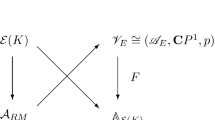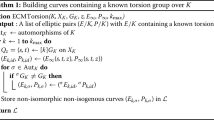Having expressed the ratio of the length of the lemniscate of Bernoulli to the length of its cocentered superscribing circle as the reciprocal of the arithmetic-geometric mean of 1 and \( \sqrt{2} \), Gauss wrote in his diary, on May 30, 1799, that thereby “an entirely new field of analysis” emerged. Yet, up to these days, the study of elliptic functions (and curves) has been based on two traditional approaches (namely, that of Jacobi and that of Weiestrass), rather than a single unifying approach. Replacing artificial dichotomy by a methodologically justified single unifying approach not only enables rederiving classical results eloquently, but allows one to undertake new calculations, which seemed either unfeasible or too cumbersome to be explicitly performed. Here, we shall derive readily verifiable explicit formulas for carrying out highly efficient arithmetic on complex projective elliptic curves. We shall explicitly relate calculating the roots of the modular equation of level p to calculating the p-torsion points on a corresponding elliptic curve, and we shall rebring to light Galois’ exceptional, never really surpassable, and far from fully appreciated impact. Bibliography: 19 titles.
Similar content being viewed by others
References
S. Adlaj, “Galois elliptic function and its symmetries,” in: N. N. Vassiliev (ed.), 12th International Conference on Polynomial Computer Algebra, St.Petersburg (2019), pp. 11–17.
S. Adlaj, “On the second memoir of Évariste Galois’ last letter,” Computer Tools in Science and Education, 4, 5–20 (2018).
S. Adlaj, Thread Equilibrium in a Linear Parallel Force Field [in Russian], LAP Lambert, Saarbrucken (2018).
S. Adlaj, “An analytic unifying formula of oscillatory and rotary motion of a simple pendulum,” in: I. Mladenov, A. Ludu, and A. Yoshioka (eds.), Proceedings of the International Conference “Geometry, Integrability, Mechanics and Quantization,” Avangard Prima, Sofia (2015), pp. 160–171.
S. Adlaj, “Torsion points on elliptic curves and modular polynomial symmetries,” presented at the joint MSU-CCRAS Computer Algebra Seminar on September 24, 2014; available at http://www.ccas.ru/sabramov/seminar/lib/exe/fetch.php?media=adlaj140924.pdf.
S. Adlaj, “Modular polynomial symmetries,” in: N. N. Vassiliev (ed.), 7th International Conference on Polynomial Computer Algebra, St.Petersburg (2014), pp. 4–5.
S. Adlaj, “Elliptic and coelliptic polynomials,” in: 17th Workshop on Computer Algebra, Dubna, Russia (2014); available at http://compalg.jinr.ru/Dubna2014/abstracts2014 files/1159.pdf.
S. Adlaj, “Mechanical interpretation of negative and imaginary tension of a tether in a linear parallel force field,” in: Selected Works of the International Scientific Conference on Mechanics “Sixth Polyakhov Readings,” St.Petersburg State University, St.Petersburg (2012), pp. 13–18.
S. Adlaj, “Iterative algorithm for computing an elliptic integral,” in: Issues on Motion Stability and Stabilization [in Russian] (2011), pp. 104–110.
S. Adlaj, “Eighth lattice points,” arXiv:1110.1743.
E. Betti, “Sopra la risolubilit`a per radicali delle equazioni algebriche irriduttibili di grado primo,” Annali di scienze matimatiche e fisiche, II, 5–19 (1851).
E. Betti, “Un teorema sulla risoluzione analitica delle equazioni algebriche,” Annali di scienze matimatiche e fisiche, V, 10–17 (1854).
D. Cox, “The arithmetic-geometric mean of Gauss,” Mathématique, 30, 275–330 (1984).
É. Galois, “Lettre de Galoisà Auguste Chevalier,” J. Math. Pures Appl., XI, 408–415 (1846).
C. Hermite, “Sur la résolution de l’équation du cinquième degré,” C. R. Acad. Sci., XLVI(I), 508–515 (1858).
S. D. Meshveliani, “Computer proof for a ‘mysterious’ equality for quartic roots,” in: 17th Workshop on Computer Algebra, Dubna, Russia (2014); available at http://compalg.jinr.ru/Dubna2014/abstracts2014 files/1199.pdf.
J-P. Serre, A Course in Arithmetic, Springer-Verlag, New York (1973).
G. Shimura, Introduction to the Arithmetic Theory of Automorphic Functions, Princeton Univ. Press, Princeton (1981).
L. A. Sohnke, “Aequationes modulares pro transformatione functionum ellipticarum,” J. Reine Angew. Math., 16, 97–130 (1837).
Author information
Authors and Affiliations
Corresponding author
Additional information
Published in Zapiski Nauchnykh Seminarov POMI, Vol. 485, 2019, pp. 24–57.
Rights and permissions
About this article
Cite this article
Adlaj, S. Multiplication and Division on Elliptic Curves, Torsion Points, and Roots of Modular Equations. J Math Sci 251, 315–338 (2020). https://doi.org/10.1007/s10958-020-05093-5
Received:
Published:
Issue Date:
DOI: https://doi.org/10.1007/s10958-020-05093-5




